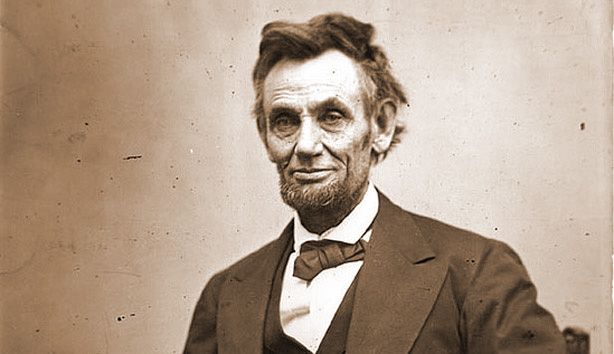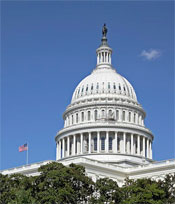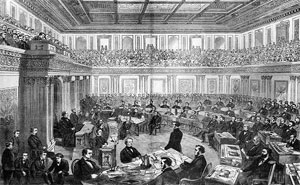Web Feature Posted September 20, 2012
Constitution Day 2012: Survivor Lincoln's Constitution and His Impeachment Trial
By William Woodward, Professor of History
 President Abraham Lincoln, photo taken by Anthony Berger on February 9, 1864, Washington, D.C.
President Abraham Lincoln, photo taken by Anthony Berger on February 9, 1864, Washington, D.C.
Remarkably, the assassin’s shot proved nonfatal. The president survived the wound.
Unhappily, the vice president did not. Andrew Johnson died at a second assailant’s hand, even as Wilkes Booth’s bullet failed in its lethal intent. Upon the surviving Abraham Lincoln would fall the task of overseeing Reconstruction after the Civil War.
That counterfactual premise undergirds Stephen Carter’s new novel, The Impeachment of Abraham Lincoln, a gripping yarn with a serious thrust: What if the president had lived? What if the shrewd and popular Lincoln, rather than the hapless Johnson, had become the target of Congressional wrath after the war?
What if the first-ever presidential impeachment trial under the U.S. Constitution had attempted the removal of one of the great constitutional thinkers and practical politicians of the age? And what might we learn about our living Constitution from this imagined clash between executive and legislative branches?
It’s a pressing question this fall as we slog through another contentious presidential election campaign, anticipating what the relations might be between the new Congress and either Barack Obama or Mitt Romney. So on this Constitution Day, September 17, 2012, it seems worth a look at Carter’s historical fiction to glean insights into our contemporary reality. In so doing, I resume a series that has focused on Lincoln and the Civil War, looking specifically in 2010 at Lincoln’s wartime exercise of presidential power.
Constitution, Politics, Philosophy
The question of presidential power is a constitutional matter, and a political matter, and a philosophical matter. The American system is deliberately structured for perpetual political jockeying. Partisan rivalry intensifies and complicates the contest. Yet even when the same party “controls” both Congress and the presidency, as in the Republican-dominated aftermath of the Civil War, the separation of powers invites conflict.
 The United States Capitol building seen from the eastern end of the National Mall, Washington, D.C. Photo by Carol M. Highsmith.
The United States Capitol building seen from the eastern end of the National Mall, Washington, D.C. Photo by Carol M. Highsmith.
As the Constitution intends.
We call it “checks and balances.” The Constitution was born out of deep suspicion of unaccountable power. Government rules by consent of the governed through election of representatives serving for fixed terms, granting one measure of accountability to the people. In between elections, however, where is the accountability?
That’s where impeachment fits in. What happens if the balances get off kilter? What if the chief executive breaches constitutionally intended limits? In egregious cases, Congress can try to remove the president through impeachment and trial.
The grounds for such formal charges might or might not be indictable criminal acts. The Constitution’s language grants some wiggle room: the president can be removed for “Treason, Bribery or other high Crimes and Misdemeanors.” The Framers provided, in short, for both how the president attains office and how he (someday she) may be kicked out. Certainly the tenor of the text contemplates outrageous stuff: treason and bribery are surely “high crimes.” But what’s a “misdemeanor”? A speeding ticket? Lying to the people? Tax evasion? Infringing civil liberties? Securities fraud?
To decide that question is a political calculation, especially for the House of Representatives, which has “sole power” to impeach (i.e., bring charges against). (Once the House formally adopts the charges, the Senate sits as jury, needing a two-thirds majority to convict and remove from office.)
So Carter (p. 458) has Lincoln’s political enemies in the House, the so-called “Radicals” within his own Republican party, charging that Lincoln has grossly transgressed “in threatening and embarrassing the other branches of government,” compelling the Congress to “step in and correct the wrong.” In rebuttal, he has Lincoln’s defense counsel contend that “unless you are able to show the clear violation of a criminal statute, the proper forum for the expression of a disagreement over policy is the ballot box, not the court of impeachment.”
Which is where one’s philosophy of government fit in. How much power is too much, whether wielded by a single individual from the White House, or 535 members of Congress, or the whole federal establishment? Conversely, how much power is enough? Enough to defend the nation from external attack, internal rebellion, fraudulent finance, gang violence. Enough to protect civil rights, guarantee equal opportunity, advance the health of individuals and ecosystems, compete in a global economy.
Enough, in short, to “establish justice, ensure domestic tranquility, provide for the common defense, promote the general welfare, and secure the blessings of liberty,” as the Constitution’s Preamble announces.
Fiction: Lincoln's Impeachment Trial
Stephen Carter, a Yale law professor, surely has that supreme constitutional vision in view as he probes the question of presidential power. He frames his political drama within a page-turning murder mystery, with a compellingly drawn central character. A young free black woman, a graduate of Oberlin College, returns to her native Washington city after the war. Commended by Oberlin’s president, the Rev. Charles Finney, Abigail is hired by a D.C. law firm, the same firm retained by President Lincoln to defend him from the impending charges. When one of the firm’s partners is killed, Abigail begins her own probe, gradually finding hints that the murder and the impeachment are somehow connected. Others dismiss the inferences and even block her inquiries. Their consuming focus is the trial, and above all constructing a defense that can sway enough undecided senators to keep Lincoln at the helm.
Implicitly, to succeed in securing acquittal will preserve the independence and prerogative of the chief executive. To fail will bring down not just Abraham Lincoln, but also the institution of a powerful presidency. And for Lincoln’s enemies, that would be a good thing. Carter has Senator Charles Sumner say (p. 118): “Never in the history of our Protestant Republic has one man gathered to himself as much power. ... He has nearly sunk the other branches. ...”
“In other words,” retorts congressman and Lincoln strategist Dan Sickles (p. 83), “they are irritated at Mr. Lincoln for making up his own mind.” They “will not be satisfied until they can give orders to the President.”
Thus Carter sets the stakes, for that day and ours. He then puts in Lincoln’s own mouth the potential consequences (pp. 42-43): “The Radicals never thought I was the man to fight the war, and now they do not think I am the man to make the peace. I long only to recreate the Union. ...” Though one might prefer simply to escape the pressure, “the work of binding up the Union is not yet completed, and until it is, I cannot yield.” Who is ultimately in charge of the fate of the nation?
The real Lincoln, as wartime commander-in-chief, indeed acted as the first two articles alleged, on grounds that the president in extreme emergencies may need to infringe a part of the Constitution to save the whole. In Carter’s telling, Lincoln did not contest the facts of these first and second articles, only the inference that they had no constitutional warrant. After the war, the real Andrew Johnson indeed gave little priority to the former slaves, which led to his defiance of congressional efforts to take over the management of reconstructing the south. Carter’s Lincoln and his attorneys carefully attack the prosecutors’ case on the third and fourth charges, on grounds that he cares for the black population but asserts presidential prerogative against a congressional power-grab.
Thus Carter sets up his 2012 readers, not just the 1867 senators, as jurors who must weigh the arguments and resolve the question of presidential power.
And through it all he interweaves the brilliant ideas and savvy actions of his protagonist, always sketching the political, social, racial, and underground worlds of the postwar capital. From my perspective, he does so with an impressively sure hand for scenery, personality, and dialogue. The Impeachment of Abraham Lincoln thereby serves well the function of historical fiction: to bring alive with wit and authenticity a particular time and place, while letting timeless matters of the human condition arise from the story.
History: The Impeachment of Andrew Johnson
 The Senate as a court of impeachment for the trial of Andrew Johnson. Sketch by Theodore R. Davis held in the Library of Congress Prints and Photographs Division, Washington, D.C.
The Senate as a court of impeachment for the trial of Andrew Johnson. Sketch by Theodore R. Davis held in the Library of Congress Prints and Photographs Division, Washington, D.C.
For all Carter’s radical departure from history, his account intersects with what actually happened. Lincoln of course did not survive the April 1865 assassination; Vice President Andrew Johnson did, and assumed the presidency at war’s end. Purporting to fulfill Lincoln’s plan for charitable restoration of the South, he quickly offered easy terms by which Southern state governments could be reconstituted and readmitted.
He did all this on his own authority as chief executive, for Congress was not in session from March to December 1865. That failure to include the legislative branch in the Reconstruction process backfired. But that was typical of the man.
Tennessean Andrew Johnson rose from humble origins to political prominence by appealing to common folk against the rich planter class. But not only was he anti-slave owner, he was anti-black. And he had a contrarian personality evident in his fierce unionist defiance of the secessionists. When Tennessee bolted the Union, then-Senator Johnson stayed in his seat. Appointed military governor when Tennessee fell to federal forces, he was tabbed as Lincoln’s running mate in 1864. Sure enough, the staunch unionist and former Southern Democrat gave appealing balance to the Republican slate.
Even Lincoln, as Carter’s fictional scenario presumes, would have struggled to outmaneuver the radical Republican majority in Congress, sworn to punish the South and protect the freed slaves. Johnson’s background, personality, lack of sympathy with the freedmen, and political ineptitude guaranteed an epic clash.
As I explained in my 2011 Constitution Day essay, Johnson would not — could not — compromise or outmaneuver. He vetoed several bills, including a civil rights package, which alienated the large moderate faction, one-time Lincoln allies. With these moderates joining the radicals, Congress seized the initiative, passing tough Reconstruction legislation over Johnson’s repeated vetoes. One of these bills restricted the president’s right to dismiss a member of his Cabinet. When Johnson — convinced this was an unconstitutional invasion of executive power — fired the Secretary of War, the House of Representatives voted to impeach.
Just eight months before Johnson’s successor would be picked in the regular November election, the impotent but unbending president faced trial before the Senate. The formal charges defined the following alleged “high crimes and misdemeanors”:
he ... did unlawfully ... issue an order in writing for the removal of Edwin M. Stanton from the office of Secretary for the Department of War. ... [and] unmindful ... of the harmony and courtesies which ought to exist and be maintained between the executive and legislative branches ... did attempt to bring into disgrace ... the Congress of the United States. ...
In short, the objective act triggering the impeachment was Johnson’s attempt to discharge an appointed officer, but the deeper issue at stake was the relative power and prestige of the two branches of government. It was a political, not a criminal or constitutional dispute, multiplied by mutual personal venom.
As it played out, the Senate fell one vote short of the needed two-thirds to remove the president. Johnson survived to serve out his term, irrelevant and powerless. And the presidency remained a crippled institution until the 20th century. Such was the outcome of this ultimate exercise of the “checks and balances” built into the Constitution.
Filling the role of artful novelist rather than law professor, Stephen Carter offers no judgment on the legitimacy of the impeachment tool. He plays with a counterfactual possibility, draws on the Johnson trial for some of the arguments on both sides, deftly interweaves intrigue and romance, and concludes with ...
No, I won’t spoil it for you.
Impeachment and Poisoned Politics
But I can say that it is my judgment that the impeachment process, now as then, is an extreme, and extremely politicized, weapon, not a mere constitutional mechanism. It must necessarily require a poisoned and polarized political atmosphere, and a president who is the object of palpable hatred. It’s part of our Constitution, and has worked appropriately to remove corrupt lower-tier officers of all three branches. But at the highest level, history suggests, it is a marker for a dangerous and dysfunctional political environment.
Impeachment has been seriously attempted four times. In the 1840s, John Tyler, like Johnson an “accidental president,” ran afoul of his own party leaders in Congress for vetoing their signature bills, but their outrage never gained real traction. Richard Nixon escaped an impeachment vote and likely trial by resigning in 1974. While arguably criminal behavior — willful “cover-up” of the cluster of illegal acts remembered as the Watergate scandal — triggered the presentation of impeachment articles, Nixon had been despised by his opponents for two decades, a cold hatred he reciprocated. His efforts to find and punish his (and what he saw as the country’s) “enemies” led to the morass of legal and ethical transgressions revealed in the Watergate exposés. That he may have been right that the “dirty tricks” of his minions had precedents in previous administrations provides no excuse. One may reasonably conclude that impeachment was a legitimate recourse, despite the bitter context.
But what about Bill Clinton? His impeachment exposed sordid if not criminal behavior, to be sure. And the allegation of perjury seems to fit into the “high crimes and misdemeanors” rubric. But the American people seemed to feel, and the Senate vote against removal confirmed, that the impeachment tool owed as much to political vendetta as to legal or constitutional trespass.
What troubles me most, then, is the linkage of the drastic measure of presidential impeachment to political hatreds. Whatever the merits of the legal case for a president’s “high crimes and misdemeanors,” visceral hostility seems to shape the environment when some seek to remove the chief executive of our nation.
And Stephen Carter’s novel makes it clear how much that observation applies to his fictional post-Civil War world.
So does Carter want us thinking not only about the ongoing contest between presidential and congressional power, but also the overreach that can follow from brute political and personal bile?
If he doesn’t, I do. Of our nine recent presidents, from Lyndon Johnson to Barack Obama, only three escaped what I consider to be irrational personal hostility. (And those three — Gerald Ford, Jimmy Carter, and George H.W. Bush — all failed to be re-elected. Go figure!)
Stephen Carter’s own intent aside, what I commend to those who join me in reading and pondering a great and gripping story is a willingness, out of respect for the great Charter we honor this Constitution Day, to speak against a poisoned culture that routinely descends to a politics of hate.
Editor's note: Read Response magazine's interview with Stephen Carter, Seattle Pacific University's first Day of Common Learning keynote speaker in 2002.
Professor of History William Woodward joined the Seattle Pacific University faculty in 1974. He specializes in the history of the Pacific Northwest, especially military history, as well as 19th century American culture. The recipient of numerous grants and honors, Dr. Woodward also gives public lectures on history and is a consultant to school districts and historical societies.
For information about the U.S. Constitution and about Constitution Day, September 17, visit the National Constitution Center. You can also read more Constitution Day essays by Dr. Woodward. University.
Read more Reponse web features.
